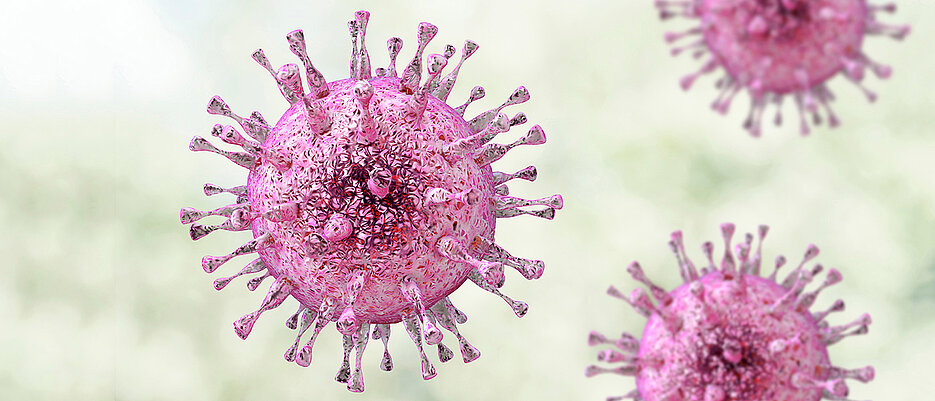New research unit approved
04/03/2019A new international research group aims to develop new approaches to prevent and treat cytomegalovirus infection. Lars Dölken, a virology expert from Würzburg, is the research unit's spokesman.

"Cytomegalovirus, beware of this new research group!" This could be the motto of a new research unit recently approved by the German Research Foundation (DFG). It is titled: "Advanced concepts in cellular control of cytomegalovirus ".
Professor Lars Dölken, who holds the Chair of Virology at the Institute for Virology and Immunobiology at the University of Würzburg, is the spokesman of the research unit which brings together scientists from Würzburg, Freiburg, Tübingen, Hannover, Braunschweig and Croatia. The DFG will fund the research unit with EUR 3.4 million for the first three years. Around EUR 1.4 million of the funding amount will be allocated to the University of Würzburg.
Cytomegalovirus – the dormant enemy within
Cytomegaloviruses are members of the herpesvirus family. Human cytomegalovirus (HCMV) is the largest human virus and encodes hundreds of viral proteins in its genome. "They allow the pathogen to manipulate almost all human immune defence mechanisms developed during the course of evolution," Lars Dölken explains. However, the virus is asymptomatic in most people with a healthy immune system. "It has perfectly adapted to the human host in the course of evolution," the virologist says.
Around half of the population in Germany is infected with HCMV. The rate is as high as 90 percent in some countries. Most people get infected as children. They usually have few if any flue-like symptoms, including tiredness, muscle aches, headaches, fever and enlarged lymph nodes similar to infectious mononucleosis. As all herpesviruses, HCMV establishes lifelong infections that cannot be eradicated from the body.
"It does not cause any problems in people with a healthy immune system. But the virus can reactivate in patients whose immune system is compromised as a result of immunosuppressive therapies to treat autoimmune diseases and cancer. This can readily become life threatening," Professor Hartmut Hengel says. He holds the Chair of Virology at the Freiburg University Hospital that is a member of the research unit. This is especially critical for patients who have received a stem cell transplant to treat leukaemia or lymphoma.
In addition to drug therapy approaches, immunotherapies have therefore become increasingly important over the past years, especially the production and administration of virus-specific T cells. "While these novel therapies yield astonishing results in some patients, they unfortunately still fail in others," Dölken says.
Restoring immunological control mechanisms
The new research unit focuses on the interaction of the virus-infected cell with two central constituents of the immune systems, T cells and natural killer cells (NK cells). Both cell types are capable of recognizing the infected cells using special receptors on their cell surface and eliminating them subsequently. The central goal of the research unit is to understand:
• how cells infected by the virus are recognized by human immune cells
• how these immune cells are then activated and perform their control function
• and how these insights can be harnessed to improve immunologic control in patients with a compromised immune system.
Bringing together basic research and clinical practice
Each of these three goals will be tackled by three dedicated subprojects. To achieve this, basic researchers will be working hand in hand with clinicians. In a first step, the scientists want to determine which gene products the cytomegaloviruses of humans and mice actually possess. "Not an easy task given the huge genome which includes hundreds of eligible genes," the virologists admit. Afterwards, they plan to study which gene products are particularly relevant for T cells to recognize the virus infected cells and how these T cells as well as NK cells are activated. These data will then be used to improve the production of virus-specific immune cells at the university hospitals in Würzburg, Freiburg and Hannover.
The research efforts require a broad spectrum of expertise in virology, immunology and methodology. The participating institutions hence represent a wide range of disciplines. The research group combines the huge potential of modern analysis procedures in systems biology, the latest in imaging technology such as two-photon excitation microscopy, established animal models and new knock-out models with work on clinical patient samples.
Their goal is to transfer the insights gleaned from basic research to new diagnostic, prophylactic and therapeutic procedures to be able to identify and treat both patients who are at risk and patients suffering from an active HCMV infection more effectively in the future.
DFG research units
DFG research units enable scientists to commit themselves to relevant and pressing issues in their respective disciplines and establish innovative research directions. At present, the research units are funded for a period of up to six years which will be extended to a maximum of eight years in the future.
Contact
Prof. Dr. Lars Dölken, Department of Virology, Institute for Virology and Immunobiology
T.: +49 931 31-88185, lars.doelken@uni-wuerzburg.de






